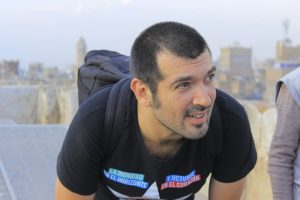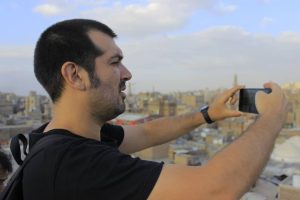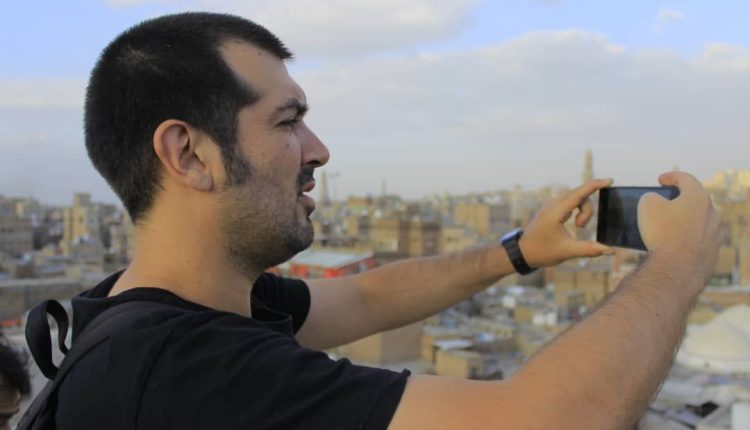Chronicle from Yemen (II): Sana’a’s wound bleeds for Gaza
The airport welcomes us amidst the wreckage of bombed planes and destroyed towers. Yemen, the only republic on the Arabian Peninsula, has endured a war of aggression by neighboring monarchies for ten years, and its capital, Sana’a, is one of the hardest hit areas.
Our trip is part of the efforts to break the blockade and isolation that the aggressor coalition, led by Saudi Arabia and the United Arab Emirates but directed by the US, imposes on 26 million of the 35 million Yemenis who live in the country, controlled for a decade by the popular government.
In a brief chronological summary of the situation, we can say that the Al Houthi family formed the Ansar Allah group in the 1990s, a peaceful Islamic movement opposed to Wahhabism (the ideology of Saudi Arabia, Al-Qaeda, and the Islamic State). The ruling regime responded by assassinating its leader and imposing six wars on them between 2004 and 2009. The movement emerged victorious from these wars, consolidated its power in the north of the country, and achieved significant national presence.
In 2011, the Yemeni Arab Spring overthrew the president of the previous 30 years, leaving in his place… the vice president. Power remained in the same hands as always, and the accumulated unrest was capitalized on by Ansar Allah, which launched the Popular Revolution on September 21, 2014. The vice president/president fled to Saudi Arabia and, to this day, established a “government in exile” (which has a legitimacy similar to Juan Guaidó’s) supported by Americans and Saudis. Meanwhile, the legitimate Yemeni government faces isolation and punishment from the “International Community” and its institutions such as the UN and the WHO, and the shameful apathy and silence of the countries of the so-called Global South.
Since March 2015, when the puppet government requested that its own country be bombed to overthrow the revolutionary government, Operation “Decisive Storm” and then Operation “Restoring Hope” have been carried out. Through airstrikes, naval blockades, ground troops, and economic and commercial suffocation, a coalition of twenty countries led by the US, Saudi Arabia, and the United Arab Emirates has unsuccessfully attempted to conquer the country for the past ten years.
In the bustling, cheerful streets of Sana’a, there are no traffic lights. They are jammed with cars, motorcycles, and images. Photographs of martyrs, one after another for miles, billboards honoring the fallen of the Axis of Resistance in the fight against Zionism. Messages of support for Palestine appear on private cars, public buses, walls, and counters. Food stalls, clothing stores, pharmacies, and hardware stores, watermelons so dark green they look like enormous black olives. The old city, inhabited continuously for 2,500 years, with its markets selling wood, fruit, precious stones, and traditional curved daggers (jambiyas). Its 14 Turkish baths and its 1,400-year-old mosque.
Women, children, and girls begging for alms from drivers and passersby. Skin too close to bones, the image repeated too many times. The blockade (as we know well in Cuba and Venezuela) focuses its action on the three aspects that cause the greatest suffering to the greatest number of people and harm the weakest the most: Poverty, hunger, and disease.
One and a half million public employees, who support 3 million adults and 4 million children, cannot collect their salaries due to international theft (transfers to the puppet government) from state bank accounts. The same applies to the one and a half million poor people who survive on the Social Welfare Fund.
The hospitals, of which 54 have been attacked (leaving 36 partially out of service and 18 completely destroyed), also reflect what the UN described in 2020, the same year it cut aid to the country, as “the worst humanitarian crisis on the planet so far this century.”

The war-disabled people treated at the Rehabilitation, Orthotics, and Prosthetics Center suffer this daily. As we toured his workshops, Dr. Jabr Al-Montasir (a Cuban-trained physical therapist) told us how, unable to import prostheses, they had first begun repairing them and now manufacturing them. Now, with raw material imports blocked, they recycled irreparable ones to make crutches and other technical aids.
On the other hand, the containers of expired food or animal feed sent by the UN as “humanitarian aid” are just the icing on the cake of a famine tactic that involves blocking food imports in parallel with the destruction of the country’s almost total capacity for food sovereignty before the attack. This tactic, of course, focuses, with particular sadism, on women and children.
There are 6 million pregnant or breastfeeding women with moderate acute malnutrition and 2 million with severe malnutrition, in addition to 1 million suffering from anemia. This has resulted in an exclusive breastfeeding rate of around 30%. It is well known that malnutrition impairs physical and mental development, especially during the first two years of life, and the damage is often permanent. There are 10 million children with acute malnutrition in Yemen, including nearly 200,000 severe cases. Forty-five percent of children under 5 years of age suffer from stunted growth and short stature, despite the recently opened Special Feeding Centers established by the government throughout the country.
Continuing with children, 60% have suffered from malaria, 50% from severe respiratory illnesses, and 40% from severe acute diarrhea. Dr. Majeda Alkhateeb, anesthesiologist and director of the Al Sabeen Women and Children’s Hospital, confirmed that these conditions (mild and transient under normal conditions) become more complicated due to pre-existing malnutrition, which in turn exacerbates malnutrition, dramatically increasing hospital demand in hospitals lacking sufficient supplies (98% of medical devices are worn out or out of service, making it impossible to import spare parts to repair them), thus increasing the infant mortality rate.
Considering the direct and indirect murder of nearly 400,000 people, the vast majority of whom are civilians, women, and children, the similarities between the strategies applied in Yemen and Gaza leave little room for doubt.
War understood not as a dispute over power, land, or resources, but as an act of extermination against the population inhabiting a territory. Indiscriminate bombing of civilians and infrastructure; blockades by air, sea, and land; torture and the disappearance of prisoners; All the global silence that money can buy while they try to subjugate a people through missiles and bombs, hunger and disease.
617,000 homes, 191 universities, 486 health centers and 37 ambulances, 1,400 schools, 13,000 agricultural fields, 15 airports, 16 seaports, 8,000 bridges and roads, 3,000 water tanks and bombs, 659 telecommunications networks. All destroyed. Killing devices manufactured, sold, and guided by the US and launched by its regional vassals.
A man chewing qat, sitting on the floor, greets us and unlocks the old padlock. This, the Grand Hall, was one of the largest event centers in Sana’a, and on that October 8, 2016, thousands had gathered for the funeral of a respected sheikh. The sandals and shoes at the entrance, abandoned in the stampede when the first bomb fell. The chandeliers still hang as we look down at the 3-meter-diameter hole. Walking through the rubble, we hear how the Saudis waited for rescue teams to arrive to assist the wounded, before dropping the second bomb, which we can almost see falling with hatred through a second hole that bears witness to it. The roofs are blackened by the fire. 170 dead. 700 wounded.
So much Latin America in the common pain, in our eyes and skin. So much humanity united in the massacres perpetrated by American and European colonialism and in the betrayals of local lackeys. We bleed from the same wound, we share a history of oppression and resistance.

In the various meetings we participated in, we emphasized, on both sides, the many similarities. While we talk about the American Genocide, Simón Bolívar, the Monroe Doctrine, Fidel, Che Guevara, Allende, the Condor Plan, the Mothers of the Plaza de Mayo, the Manuel Rodríguez Patriotic Front, Chávez, CELAC, ALBA, and the Chilean Social Outburst, the ENTESAF comrades tell us about their battle to expose the crimes committed against women and children, the Prisoner Affairs comrades tell us about their struggle to bring their loved ones back from enemy prisons at home and abroad, and the Foreign Ministry and NTFO tell us about their diplomatic efforts to break the isolation and blockade imposed by the Gulf Monarchies and complied with by international “humanitarian” organizations.
But let’s be fair. The bombings (those of the Saudi-US coalition) stopped in 2022. After resisting the siege of the capital and major cities during the first four years of the war, in 2019 the Yemeni government began bombing positions inside Saudi Arabia (military airports and refineries). The Americans withdrew first in 2021, overwhelmed by successive defeats in the Red Sea. Then it would be the Saudis’ turn and their “unilateral ceasefire,” attempting to cover up the monumental failure of the aggression. There are still places in the hands of the Saudi coalition, such as the port of Aden and the island of Socotra (held by the United Arab Emirates), and cities “split in two,” such as Taiz and Marib.
From this stalemate, characterized by the same comrades as “neither war nor peace,” the attack focused on economic suffocation to deepen the humanitarian crisis. Therefore, we found ourselves in the strange situation of visiting Yemen during the few weeks that the Zionist entity’s ceasefire in Gaza lasted. No bombs or missiles fell during our stay. And we asked, why risk repeating all the destruction that has befallen these lands in the last decade, for a cause more than 2,000 kilometers away?
Ali spent long nights with us, talking about politics, culture, philosophy, ideology and religion. About his feelings and ours. He had been wounded by an F-16 on the front lines, taken prisoner, and imprisoned in Saudi Arabia for five years. Three years earlier, he had been released in the last exchange. We told him, on one of the last nights, that we considered him a hero. He told us with honest humility that he was only doing what every human being who knows their moral and religious obligations should do, and added for greater clarity, “Everything we have done, from the Saada wars in the 2000s until now, has been merely a grand preparation for the final, most important battle. We will only rest when we achieve our main objective: the liberation of Gaza.”
Today they are once again under fire, suffering bombings of civilians in most of the major cities. With their lackeys now surrendered and their allies intimidated, the US, for the first time in many years, has had to use its own armed forces to attack this so-called “poorest country in the Middle East,” so that the Zionist entity can continue perpetrating its genocide and ethnic cleansing in Palestine undisturbed.
Having failed to attack military targets and having to (once again) relocate its ships out of Yemeni reach, the US has adopted the tactic, already legitimized by the Zionist entity, of causing civilian casualties as its main objective to discourage the population and force them to beg for mercy. The country has counted hundreds of people killed in the last three weeks.
Once again, and as has happened time and again in the last twenty years, they chose the wrong enemy. The resolve of the Yemeni people and their revolutionary government is unwavering. Nothing and no one will stop them or make them retreat in the struggle for the liberation of Palestine. Sana’a, until final victory, will continue to bleed for Gaza.
Roberto Bermúdez Pellegrin, President of the Raúl Pellegrin Foundation
Pablo Sepúlveda Allende, President of the Dr. Salvador Allende Latin American Foundation

